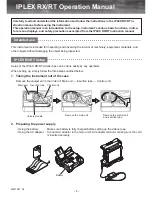
Chapter 13: Token Ring Cards
Token Ring Operational Detail
184
SmartBits System Reference
Bit 0 when set will enable the generation of Standby Monitor Polls in TKP mode. The
card has to have an established BIA
(“Burnt In Address”
- that is card MAC address) for
this mode to function.
Generating a Fiber Key
The 802.5j Fiber Connection specification describes a
key
that is intended to be used to
trigger the generation of a phantom current over a fiber link.
This key consists of two short interruptions of the idle pattern. The pattern is switched off
for about 800
µ
Sec, on for about 1.6mSec, off again for about 800
µ
Sec and on again for at
least 1.6mSec. The key is returned by the port end of the link once recognized.
The fiber key is normally enabled and will be transmitted approximately once per second
from a station when the ring or DTR link is inactive.
The fiber key should not cause a problem to most Token Ring equipment. If that
equipment does have a problem - for example, it’s a fiber interconnect system that
generates its own key sequences so can’t tolerate externally generated sequences - then the
user can inhibit this facility using the
TRA
command. (See the previous topic
regarding this command for details.)
Dedicated Token Ring (Full Duplex) Operation
Dedicated Token Ring protocols are designed to be used on a point to point link between a
single station and a concentrator (or a switch acting as a concentrator). This link can
operate in one of two modes:
•
Token Passing (“TKP”)
- essentially the same as the normal Token Ring operation
•
Transmit Immediate (“TXI”)
- a new mode that does not use token access protocols
We use the notion
Full Duplex
to indicate TXI operation.
This version of the code allows the TR-8405 to operate as an adapter in TXI mode. Since
connecting to a concentrator requires an exchange of MAC frames and will include a
Duplicate Address Test the TR-8405 will require a unique
BIA
(“Burnt In Address”).
When the card is set to
full duplex
it will try to connect to a concentrator by issuing
Join
Request
MAC frames at one second intervals. Once the request is acknowledged it will
perform a lobe test, raise the phantom and issue an
insert reques
t. This process is very fast
- it takes a fraction of a second - and will time out if the concentrator fails to respond
promptly. Once the connection is established it is maintained using a
heartbeat
frame
exchange where the TR-8405 replies to frames sourced by the concentrator.
If the heartbeat fails, then the TR-8405 will time out the connection and restart the join
process.
The concentrator can force the TR-8405 back to normal Token Ring operation at any time
by issuing a
Claim
MAC frame.
Summary of Contents for SmartBits System
Page 8: ...viii SmartBits System Reference ...
Page 58: ...50 SmartBits System Reference ...
Page 82: ...74 SmartBits System Reference ...
Page 88: ...80 SmartBits System Reference ...
Page 196: ...188 SmartBits System Reference ...
Page 202: ...194 SmartBits System Reference ...
Page 218: ...210 SmartBits System Reference ...
Page 238: ...230 SmartBits System Reference ...
Page 278: ......
















































